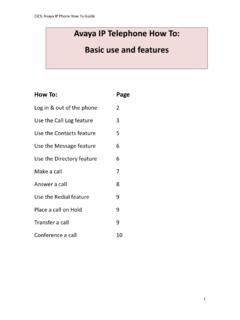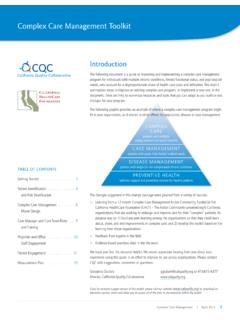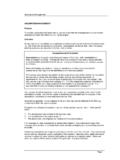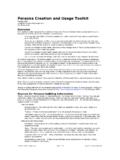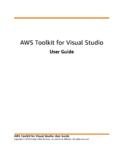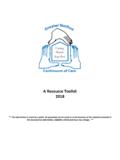Transcription of Benefits Management Toolkit - INFLUENCE
1 Benefits Realisation Management Toolkit for Project Managers CiCS Programme & Project Unit 1. Introduction This document has been developed by the Programme & Project Unit for use by CiCS Project Managers. The aim has been to provide Project Managers with a simple, straightforward guide with which to introduce Benefits Realisation Management (BRM) to their projects. It is hoped that this document will provide a valuable source of information that will be of use throughout all stages of a project. The document aims to provide: An understanding of the basic principles of BRM and how it fits with the CiCS Project Management methodology An overview of the main tools of BRM - the Benefits Workshop and the Benefits Map An overview of the practicalities of applying BRM to projects Further information regarding BRM or guidance on its application can be obtained by contacting the Programme and Project Unit.
2 2. What is BRM and why should we use it? BRM is a tool to help us get the most from project deliverables. Used successfully, it will help to maximise the Benefits that users obtain from systems/services. BRM helps to: Define and deliver project aims and expected project Benefits Deliver services that users want and will use (user satisfaction). Keep the project team focussed on project aims and Benefits Start up a project - Information generated by the Benefits Workshop (project aims, Benefits , enablers, changes, stakeholders, resources etc) feeds directly into the Project Definition document - The Benefits Workshop can be used as a team building exercise (Forming, Storming, Norming, Performing).
3 Plan and prepare for project handover/rollout - Identify the scale of changes required to working practices & culture and the tasks and resources required to deliver these changes - Ensure resources are available for rollout/change Management - Encourages the project team to keep an eye on project closure & handover from the start of the project Plan and gather measures (usually after the project itself has closed). - are services being used? - If not, why? - Are users satisfied? - Is the full potential of a new system/service being realised? 3. Who undertakes BRM and when?
4 BRM involves the identification of project aims and Benefits ; it is therefore important to involve all relevant project stakeholders in this process to ensure that the views of all interested parties are taken into account. Stakeholder involvement from an early stage will help to gain buy-in' to the concept of BRM and also give stakeholders a sense of ownership of the process/deliverables. Some stakeholder groups are particularly large ( in the case of academic staff) and it may be impossible to involve them all in the process - in this case, it is feasible to select a representative sample.
5 It is worth noting that the role of the Project Manager is to plan for Benefits Realisation. Most project Benefits will be realised after project handover/closure (and therefore after the Project Manager has moved onto the next project!). The process of planning for Benefits Realisation will help to identify: - The scale of work required for organisational change Management activities/realising project Benefits - The resources/skills set required to undertake this work Planning for Benefits realisation should take place throughout the project lifecycle - this will involve planning for rollout, the delivery of Benefits and the tracking of measures.
6 22-Oct-08 1 of 6. 4. Benefits Workshop The purpose of the Benefits Workshop is to bring together project stakeholders (ideally at the very start of a project). to undertake a group exercise that will: Identify project aims, Benefits , organisational changes and enablers (this information can then be added to the project definition document). Lead to the development of a Benefits Map Step 1 - Aims The Benefits Workshop should start with an exercise to identify the aims of the project : What is the project trying to achieve? Why are we doing the project? To improve , To reduce , To increase , To more effectively etc.
7 - The project should support University objectives Aims set the boundary for the project scope and summarise the main purpose of the project. The project aims form the starting point for Benefits Realisation Management once we know the purpose of the project and what it is trying to deliver, we can then look at how these aims can be achieved by the delivery of appropriate Benefits . Step 2 - Benefits The next exercise is to identify the Benefits that must be delivered to achieve the aims identified in step 1 - : Improved , Reduced , Increased . These will range from operational Benefits ( increased efficiency & effectiveness) through to more strategic Benefits ( raised profile of research staff).
8 Step 3 - Enablers Once the project aims and Benefits have been identified, the next exercise is to identify the project enablers. An enabler could be a tool ( IT system), a policy ( information Management policy), a building ( Information Commons), etc Note: The enablers don't usually by themselves deliver Benefits - Benefits must be actively realised via organisational change. Step 4 - Changes This exercise should identify the organisational changes that must occur in order for the Benefits identified in step 2 to be realised - for example changes to working practice/culture and achieving user buy-in.
9 Once the above information has been gathered, a Benefits Map can be developed. 5. Benefits Map The Benefits Map provides a visual overview of the information identified during the Benefits Workshop - the project aims, Benefits , enablers and changes. The general form of the Benefits Map is as follows: Enablers Changes Benefits Aims We may already have an idea of what the enablers could be, new software, but the main direction in the workshop is right to left essentially, working backwards from the project aims, identifying the Benefits that must be delivered to achieve these aims and then identifying the enablers required to deliver these Benefits - the final step is to identify the changes that are required to make it all happen!
10 The reason for adding the changes as the final step is that we're more likely to have an appreciation of the changes involved after we've identified the enablers! if we've identified a new student administration system as the enabler, we'll then appreciate the changes that must take place (training/education and changes to working practices and culture) in order to achieve user buy-in. 6. The application of BRM. Examples of Benefits Maps used in actual CiCS projects are given in the last three pages of this document. The maps were created within Microsoft Word using text boxes, the basic shapes of an oval and a rounded rectangle, 22-Oct-08 2 of 6.

